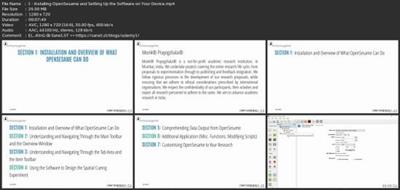M
0

Last updated 12/2015
MP4 | Video: h264, 1280x720 | Audio: AAC, 44.1 KHz
Language: English | Size: 1.20 GB | Duration: 4h 18m
A comprehensive course on building and developing customised experiments!
MP4 | Video: h264, 1280x720 | Audio: AAC, 44.1 KHz
Language: English | Size: 1.20 GB | Duration: 4h 18m
A comprehensive course on building and developing customised experiments!
What you'll learn
Easily build experiments for research in the social sciences using a graphical interface
Easily add audiovisual stimuli to create complex experiments
Create a wide variety of experiments ranging from reaction time tasks to questionnaires
Run multiple trials for your experiment with ease
Incorporate feedback into your experiment to provide your participants with information about various aspects of their performance in a given task
Understand and use the OpenSesame script to build and edit your experiment
Comprehensively record and manage data from the experiments you have created and conducted
Requirements
A computer or laptop with OpenSesame version 2.8 installed and running. OpenSesame is an open source software and a version compatible with Windows, OS X, Ubuntu or Linux can be downloaded from the following link: Description
Through this course, students will learn how to use OpenSesame, an open source, experiment building software for the social sciences. OpenSesame allows you to easily create experiments, using a graphical interface, as well as add audiovisual elements to develop more complex experiments. OpenSesame also enables you to run multiple trials of your experiments with minimum effort and it also helps to manage and record data. This course aims at teaching students how to operate this useful software. Enrolled students can expect to gain a comprehensive understanding of the various features and functions of this software, such as adding audiovisual stimuli and incorporating feedback given to participants, as well as an opportunity to create an experiment, using these different elements. This course will take ? hours to complete, (including one contact hour with the course instructor after completion of the workshop.)? The course is divided into ? broad sections, which include ? lectures and ? quizzes. An understanding of this software is important because OpenSesame is applicable to varied disciplines and is indispensible to experiment designing for a contemporary researcher. OpenSesame also makes the process of conducting experiments easier because it allows the calculation of accurate reaction times and other dependant variables as well as automatically saves and arranges data in the form of easy-to-view tables for each trial. Moreover, the comprehensive nature of this course ensures that its participants will not only be able to understand, but also apply the course content. Therefore, by taking this course, students and professionals will be armed with a powerful research tool. (For those studying at the University of Mumbai and or its affiliated colleges (Mithibai and National College), knowledge of OpenSesame is mandatory for the MA Psychology course at these institutes.)
Overview
Section 1: Installation and Overview of What OpenSesame Can Do
Lecture 1 Installing OpenSesame and Setting Up the Software on Your Device
Lecture 2 Overview of What OpenSesame Can Do
Lecture 3 Outline of the Main Panels of OpenSesame
Section 2: Understanding and Navigating Through the Main Toolbar and the Overview Window
Lecture 4 The Main Toolbar
Lecture 5 The Overview Window
Section 3: Understanding and Navigating Through the Tab Area and the Item Toolbar
Lecture 6 The Tab Area and the Item Toolbar
Lecture 7 The Loop Item
Lecture 8 The Sequence Item
Lecture 9 The Sketchpad Part 1
Lecture 10 The Sketchpad Part 2
Lecture 11 The Sketchpad Part 3
Lecture 12 The Form Items Part 1
Lecture 13 The Form Items Part 2
Lecture 14 The Response Collection Items Part 1
Lecture 15 The Response Collection Items Part 2
Lecture 16 The Logger and the Feedback Items
Lecture 17 Other Commonly Used Items
Lecture 18 The Visual Stimuli Items
Lecture 19 The Timing, Miscellaneous and Control Items
Section 4: Using the Software to Design the Spatial Cueing Experiment
Lecture 20 Outlining Experiments
Lecture 21 Explaining the Spatial Cueing Experiment
Lecture 22 Creating the Main Sequence Part 1
Lecture 23 Creating the Main Sequence Part 2
Lecture 24 Creating the Block Sequence
Lecture 25 Filling in the Block Loop with Independent Variables Part 1
Lecture 26 Filling in the Block Loop with Independent Variables Part 2
Lecture 27 Adding Images and Sound Files; Filling in the Trial Sequence
Lecture 28 Continuing to Fill in the Trial Sequence
Lecture 29 Drawing the Sketchpad Items Part 1
Lecture 30 Drawing the Sketchpad Items Part 2
Lecture 31 Configuring the Keyboard Response, Incorrect (Sampler) and the Variable Logger
Lecture 32 Adding Feedback and Setting the Length of the Loops
Lecture 33 Filling in the Instructions, End of Practice Message and Final Message
Lecture 34 Sample Run of the Experiment
Section 5: Comprehending Data Output from OpenSesame
Lecture 35 Logging Data from Experiments and Dealing with Missing Data
Lecture 36 Interpreting Data Files and Transferring them to Other Platforms
Section 6: Additional Applications (Misc. Functions, Modifying Scripts)
Lecture 37 Counterbalancing
Lecture 38 The OpenSesame Script Syntax, and Miscellaneous Functions
Lecture 39 Troubleshooting
Section 7: Customizing OpenSesame to Your Research
Lecture 40 Applying OpenSesame
Lecture 41 OpenSesame Course Notes
This course is meant for Undergraduate students, Postgraduate students, PhD students and Professionals pursuing research in the Social Sciences (Economics, Psychology and/or Sociology).,Students and Professionals from any academic discipline with a keen interest in research and experiment design are welcome to attend. A basic understanding of research methodology is recommended.

Download link
rapidgator.net:
You must reply in thread to view hidden text.
uploadgig.com:
You must reply in thread to view hidden text.
nitroflare.com:
You must reply in thread to view hidden text.
1dl.net:
You must reply in thread to view hidden text.
